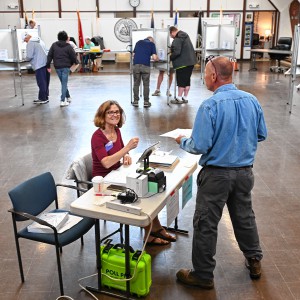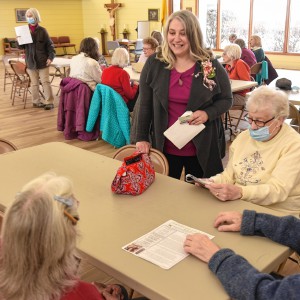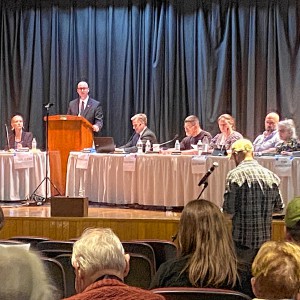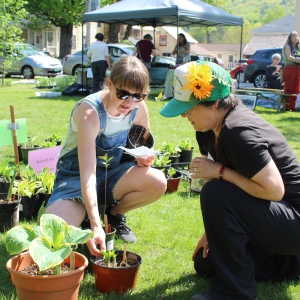Faith Matters: Nearer to God in a garden
| Published: 04-21-2023 8:11 PM |
The poet Dorothy Frances Gurney wrote “The kiss of the sun for pardon, / The song of the birds for mirth, / One is nearer God’s heart in a garden / Than anywhere else on Earth.”
When my mother read me this poem for the first time, I asked her why this was so. Her simple reply has stayed with me throughout my life: “God created all the plants, birds and animals you find in and around the garden. Surely, God tends the garden.”
As I have grown, I have tended plants and gardens everywhere I have lived. The idea that I am helping to create something useful, beautiful and wild has always stayed with me.
During the past few years, our garden had become a refuge — a place where we could sit in nature wrapped in bird song, watch the bees and butterflies, and feel safe. While we were in isolation, being in the garden helped me to not feel isolated. I communed not only with nature, but the Creator as well.
Vincent Van Gogh wrote, “… and then, I have nature and art and poetry, and if that is not enough, what is enough?”
This was one of the spiritual lessons my gardens have taught me — contentment. Being content with what rises in the spring, flowers in summer and then harvested in autumn allows us to rest, as the trees and plants do, throughout the winter. Being content spills over from garden to life. I see that there is no need for more, more, more. I have enough and am happy.
Gardening has also taught me that life is a circle. We see it in the seasons, as well as in the life and death of the plants. Sometimes, when death comes to the garden, it leaves us feeling useless and sad. What I have learned is that some plants are just not meant to grow in my garden. While they bring joy while there, their time is limited. However, if returned to the soil, they feed other flora, continuing the circle of life. Seeing this has helped me understand the death of people in my life, especially those who die in their early years.
My garden also has taught me about teamwork. When I am teaching adult students English as a second language, we talk about teamwork and how it is one of those transferable skills that you can use everywhere. If children were given gardens to tend, they would learn this lesson, as I did, early in life. A single plant can be tended by one person, but a garden most often requires at least two people to weed, plant, hoe, prune and harvest. I know for sure that our gardens would not exist if it weren’t for Roger and I working together. I simply don’t have the stamina to do it all, even if I would like to think I do.
Article continues after...
Yesterday's Most Read Articles
 Political newcomer defeats Shores Ness for Deerfield Selectboard seat
Political newcomer defeats Shores Ness for Deerfield Selectboard seat
 South County Senior Center opts not to renew church lease after rift over LGBTQ program
South County Senior Center opts not to renew church lease after rift over LGBTQ program
 More than 130 arrested at pro-Palestinian protest at UMass
More than 130 arrested at pro-Palestinian protest at UMass
 As I See It: Between Israel and Palestine: Which side should we be on, and why?
As I See It: Between Israel and Palestine: Which side should we be on, and why?
 Moratoriums on large-scale solar, battery storage passed in Northfield
Moratoriums on large-scale solar, battery storage passed in Northfield
 Bridge of Flowers in Shelburne Falls to open on plant sale day, May 11
Bridge of Flowers in Shelburne Falls to open on plant sale day, May 11
An appreciation of diverse beauty is another lesson from the garden. “A weed is but an unloved flower.” Ella Wheeler Wilcox understood this lost truth long before today’s scientists began reporting on the need to allow native plants to grow.
Milkweed, for example, has long been pulled from gardens. Many do not see the beauty of its purplish-pink flowers, its ship-like pods and its parachuted seeds. Today, science has told us that our decreasing number of monarch butterflies, an important pollinator, is because of the destruction of milkweed, which they need for sustenance, as well as to lay their eggs.
When you come to our garden, you will see milkweeds among the cultivated plants. They grow happily together. Last year, in fact, the milkweed became a stake for the morning glories that had seeded themselves at the end of the driveway.
As I am writing this, I have become aware of all the artists and poets who have included gardens in their art. One of my favorite poems, “The Little Ghost,” was written by Edna St. Vincent Millay. In it she talks about a visit by a spectral being who appears to enjoy walking through her garden. The ghost bends over to smell the mint, then, “… where the wall is built in new/And is of ivy bare/She paused — then opened and passed through/A gate that once was there.”
I would like to think that those who farmed or lived on the land I now enjoy would feel the love and joy our gardens bring. We have changed it greatly from what it was. There are woods and raised beds, a tiny pond, herbs, vegetables, perennials, bushes and a small lawn. Walking through the gardens is like visiting different lands. Each has its own personality. Some of our gardens are now mature, while others are just being birthed into existence.
Gardening is hard work, but each time I place my hands upon the soil, or touch a plant, I feel a presence that is much greater than I am. As Momma said, “Surely, God tends the garden.”
The Rev. Linda Rhinehart Neas is an ordained interfaith minister. She graduated from The New Seminary in New York City. She often fills the pulpit in local Franklin County churches. She maintains an international, online ministry through Facebook. Rev. Neas can be reached at revlindaneas2013@gmail.com and facebook.com/revlindaneas.
 Speaking of Nature: Indulging in eye candy: Finally, after such a long wait, it’s beginning to look like spring is here
Speaking of Nature: Indulging in eye candy: Finally, after such a long wait, it’s beginning to look like spring is here Celebrating ‘Seasonings’: New book by veteran preacher and poet, Allen ‘Mick’ Comstock
Celebrating ‘Seasonings’: New book by veteran preacher and poet, Allen ‘Mick’ Comstock Faith Matters: How to still the muddy waters of overthinking: Clarity, peace and God can be found in the quiet spaces
Faith Matters: How to still the muddy waters of overthinking: Clarity, peace and God can be found in the quiet spaces A time for every purpose under heaven: Free sing-a-long Pete Seeger Fest returns to Ashfield, April 6
A time for every purpose under heaven: Free sing-a-long Pete Seeger Fest returns to Ashfield, April 6
